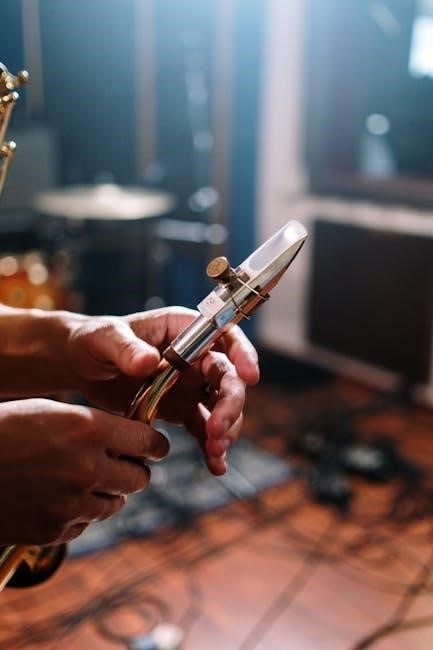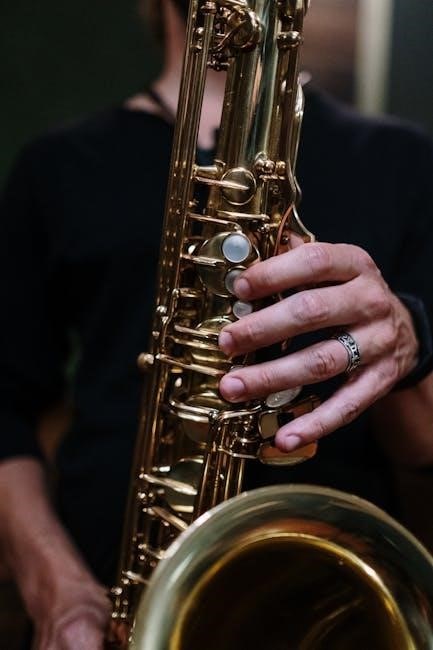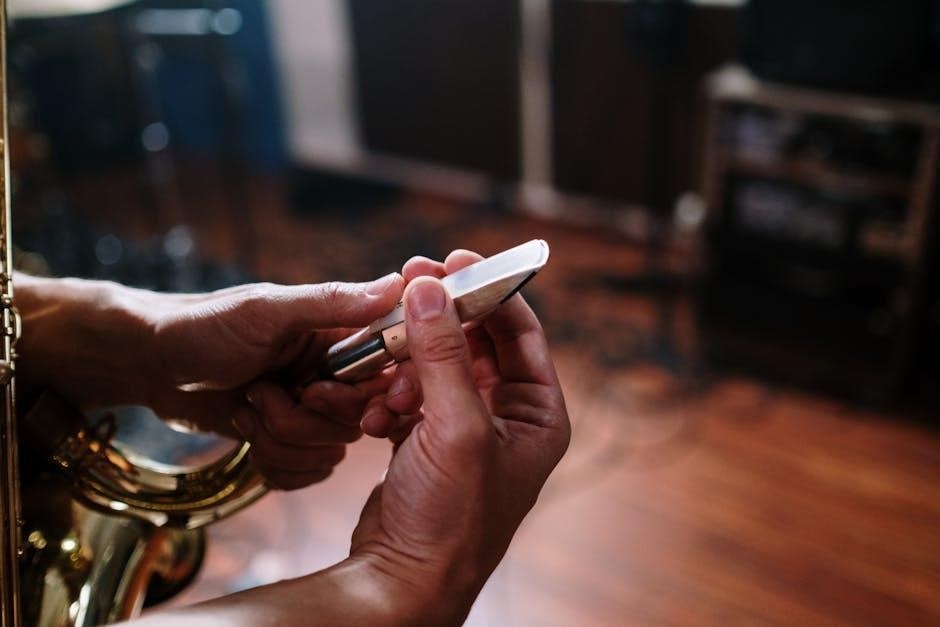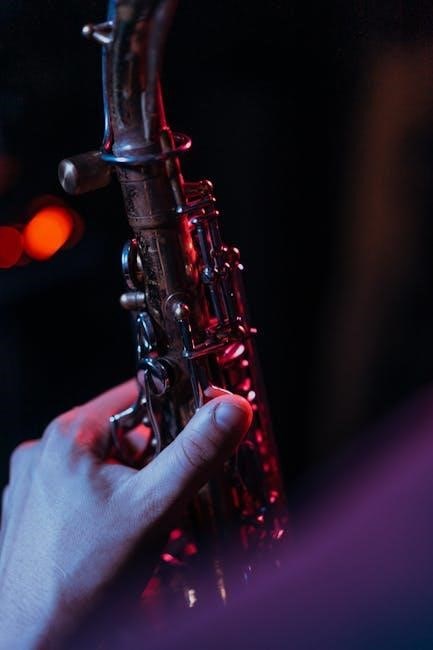Altissimo playing extends the alto saxophone’s range beyond its standard limits, offering higher notes for advanced musical expression. A finger chart provides precise fingerings for these upper register notes, enabling musicians to master the technique effectively.
Understanding the Altissimo Range
The altissimo range on the alto saxophone refers to notes above the standard high F-sharp, extending up to high C and beyond. This range requires precise fingerings and embouchure adjustments to produce clear, resonant tones. It is commonly used in advanced saxophone playing for solos and intricate passages. The altissimo range typically includes notes from high F-sharp to high C, with variations depending on the player’s technique and instrument. Mastering this range enhances musical expression and versatility, making it a key skill for professional saxophonists.
Importance of Altissimo in Advanced Saxophone Playing
Altissimo playing is crucial for advanced saxophonists, offering extended range and expressive possibilities. It enables musicians to perform complex solos and contemporary compositions. Mastering altissimo enhances technical facility and expands musical versatility, making it essential for professional performance. Proper fingerings and breath control are vital for producing clear, precise high notes. This technique allows saxophonists to explore new sonic territories, adding depth and brilliance to their playing. As such, altissimo is a cornerstone of modern saxophone technique, elevating both technical and artistic capabilities.

Structure of an Altissimo Finger Chart
A well-organized altissimo finger chart typically lists high-range notes chromatically, with corresponding fingerings clearly displayed. It often includes diagrams or tables for easy reference, ensuring players can quickly identify the correct keys and finger placements for each note. The chart may categorize notes by octaves or specific ranges, such as from F-sharp to high F, and sometimes includes alternative fingerings for versatility. Visual clarity and logical organization are key to its effectiveness as a practice and performance tool.
Key Elements of a Comprehensive Altissimo Finger Chart
A comprehensive altissimo finger chart should include clear, detailed mappings of notes to fingerings, covering the full high range of the alto saxophone. It should list notes chromatically, often from F-sharp to high F, with precise finger and key combinations. The chart should distinguish between standard and alternate fingerings, providing options for different playing styles or instrument setups. Visual clarity is essential, with diagrams or tables that make complex fingerings easy to understand. Additionally, notes on instrument-specific adaptations and common challenges can enhance its practical value for players.
How to Read and Interpret the Fingerings
To effectively use an altissimo finger chart, start by identifying the note you wish to play. Locate its position on the chart, which typically lists notes chromatically from F-sharp upward. Each note is paired with specific fingerings, often visually represented by diagrams or symbols. Pay attention to alternate fingerings, which may be marked differently (e.g., with colors or additional labels). Practice applying these fingerings on your saxophone, adjusting for your instrument’s unique response. Focus on clarity and intonation, as altissimo notes require precise embouchure and finger placement.

Popular Altissimo Fingerings for Alto Saxophone
Popular altissimo fingerings for alto saxophone include consistent patterns for notes from F-sharp to high C, with variations to suit different saxophone models and player preferences.
Fingerings for Notes from F-sharp to High C
Altissimo fingerings for alto saxophone cover notes from F-sharp to high C, providing specific key combinations for each pitch. These fingerings often involve precise use of the front F or X key, along with left-hand fingerings for upper notes. For example, the altissimo F-sharp is typically played with the first and second left-hand fingers, while high C requires a combination of left-hand keys and optional right-hand fingerings for better tuning and stability. These fingerings are standardized but may vary slightly depending on the saxophone model and player preference.
Alternate Fingerings for Improved Facility
Alternate fingerings for altissimo notes on the alto saxophone enhance playability and intonation in complex passages. For instance, high C can be played using the high F key or the alternate E key, depending on the desired tone. Similarly, E and F can be accessed using the front F or X key, offering smoother transitions. These fingerings provide flexibility, allowing saxophonists to choose the most comfortable and stable options for their instrument. Experimenting with alternate fingerings can lead to improved facility and consistency in the altissimo range.

Instrument-Specific Variations
Altissimo fingerings vary slightly between alto saxophone models due to differences in key layouts and pad sizes. Charts often highlight these variations, aiding saxophonists in navigating their specific instrument. High F# and C fingerings are particularly model-dependent, ensuring optimal tuning and response.
Adapting Fingerings for Different Alto Saxophone Models
Altissimo fingerings can vary between alto saxophone models due to differences in key layouts, pad sizes, and bore dimensions. Some saxophones, like Selmer and Yamaha, may require slight adjustments in finger placements for optimal pitch and tone. For example, the high F# and C fingerings might need alternative key combinations on certain models to ensure clarity and intonation. Players often experiment with these variations, referencing detailed charts tailored to their specific instrument. This adaptability is crucial for mastering altissimo across different saxophones, ensuring consistent performance quality.
Comparing Alto and Tenor Saxophone Altissimo Techniques
While both alto and tenor saxophones utilize altissimo techniques, key differences exist. Alto saxophones often use the front F key for altissimo A, whereas tenor saxophones rely on the high F# key. Fingerings may overlap for notes like A and B but differ for higher pitches due to instrument size. Tenor saxophones generally require more air support and a slightly firmer embouchure. Alto saxophones produce brighter altissimo tones, while tenors offer a warmer, richer sound. Understanding these variations is essential for mastering altissimo on both instruments.
Practical Tips for Mastering Altissimo
Consistently use an altissimo finger chart to learn precise fingerings and develop muscle memory. Practice long tones and scales in the upper range to improve pitch accuracy and control.
Exercises and Etudes for Developing Altissimo Skills
Mastering altissimo requires consistent practice with targeted exercises. Start with long tones to develop pitch accuracy and control in the upper range. Play scales and arpeggios starting from the altissimo F-sharp, gradually increasing speed. Incorporate etudes that focus on smooth transitions between the standard and altissimo ranges. Use articulation exercises to improve clarity and precision. Begin with slower tempos and use a tuner for accuracy. As skill improves, introduce more complex passages and vary dynamics. Regular practice with a metronome will enhance rhythm and facility. Over time, expand your range and refine your tone in the altissimo register.
Common Challenges and Solutions
Players often face challenges with pitch accuracy, unclear notes, and physical strain when mastering altissimo. To address this, practice long tones to build control and consistency. Use scales and arpeggios to improve finger dexterity and accuracy. Adjust embouchure and air support for stable intonation. Consult a teacher or reliable resources to refine technique. Experiment with alternate fingerings to find what works best for your saxophone. Regular practice and patience are essential to overcome these challenges and achieve mastery of the altissimo range.

Recommended Resources
Downloadable alto saxophone altissimo finger charts from Jazzwise and detailed guides by Christopher Barrick provide comprehensive fingerings and techniques for mastering the upper range effectively.
Top Altissimo Finger Charts for Alto Saxophone
Several high-quality altissimo finger charts are available for alto saxophonists. The Jazzwise chart is particularly popular, offering detailed fingerings for all saxophones, including alto and tenor. Christopher Barrick’s chart provides precise fingerings for notes from F-sharp to high C, ensuring clarity and accuracy. These resources are widely regarded for their comprehensiveness and ease of use, making them essential tools for musicians aiming to master the altissimo range. They are available as free downloads, catering to both beginners and advanced players.
Online Tutorials and Guides
Online resources provide invaluable guidance for mastering altissimo techniques. Websites like SaxophoneFingerCharts.com and YouTube tutorials offer detailed demonstrations and PDF downloads. These guides often include step-by-step instructions and visual aids, making complex fingerings more accessible. Many tutorials focus on specific ranges, such as F-sharp to high C, and provide tips for improving tone and control. Additionally, forums and communities share personalized advice, helping players overcome common challenges. These resources are indispensable for both beginners and advanced saxophonists seeking to refine their altissimo skills.
Mastering altissimo on the alto saxophone requires dedication and the right resources. A finger chart PDF simplifies learning, while consistent practice and proper technique ensure mastery of this advanced skill.
The Role of Altissimo in Modern Saxophone Music
Altissimo playing has become a cornerstone in modern saxophone music, particularly in jazz, classical, and experimental genres. Its extended range allows for intricate melodies and harmonies, pushing the boundaries of musical expression. Many contemporary composers incorporate altissimo techniques to create vibrant, dynamic soundscapes. The availability of detailed finger charts, including PDF resources, has made these advanced techniques more accessible to musicians. As a result, altissimo has become a vital tool for saxophonists seeking to innovate and expand their artistic possibilities in today’s diverse musical landscape.
Final Thoughts on Mastery and Practice
Mastery of altissimo playing requires consistent practice and patience. Start with lower altissimo notes and gradually progress to higher ones, ensuring proper breath control and embouchure. Use a reliable finger chart PDF to guide your fingerings and experiment with alternate fingerings for improved facility. Regularly practice exercises and etudes to build strength and accuracy. Seek guidance from experienced teachers or mentors to refine your technique. Remember, mastering altissimo is a journey that combines dedication, persistence, and a deep understanding of your instrument. With time and effort, you can unlock its full potential.



